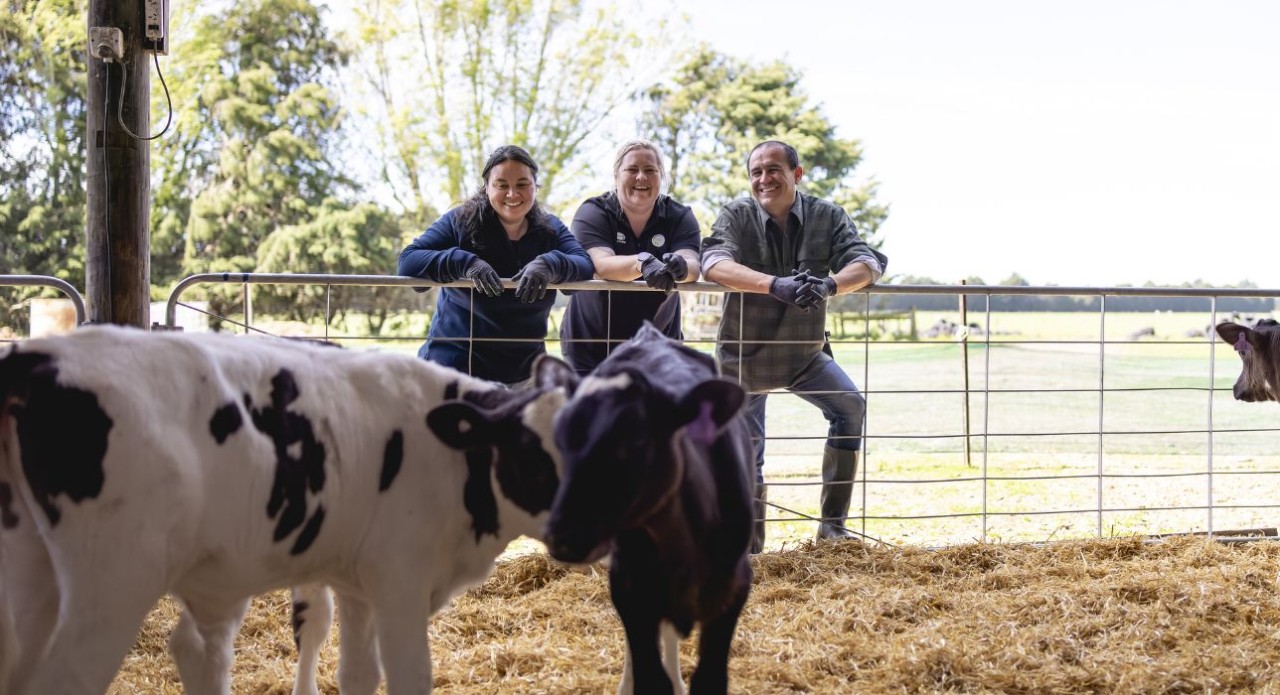Talk to your local Milk Quality Manager or visit a Farm Source store to pick up an udder health poster.
The Co-op’s milk is in demand worldwide, and it all stems from the quality milk produced on our farms. Keeping on top of risks like mastitis and high somatic cell counts early in the season minimises the risk of grades.
We talk to Farm Source Milk Programme Lead Daniel Heine and Veterinary Programme Manager Mike Shallcrass about what you can do during calving and the first few milkings to optimise your milk quality throughout the season.
Teat-spray the springers
Cows are most at risk of infection around calving and the first few milkings. The cleaner you can keep teats over this time, the better.
“If you’re bringing the cows through the shed as springers, then take that opportunity to check their udders and make sure there is no sign of mastitis pre-calving and give them a teat spray to help reduce the bacterial load on the outside of the udders prior to calving,” Mike says.
Clean teats before the first milking
The most common cause of mastitis (inflammation of the udder) is bacteria from the environment going up the teat canal and infecting the udder. The cow’s immune system responds, and you see an increase in somatic cell counts.
The first milking carries an extra high risk of infection as calcium levels tend to be low, weakening the teat sphincter and reducing the natural defences of the udder. Reducing bacterial levels by cleaning teat skin before milking reduces the risk of infection, as the teat sphincter closes more slowly for the first few milkings.
Pre-spray and post-spray colostrum mob
For colostrum cows it can help to teat spray before cupping as well as after milking, but only while they’re in the colostrum mob. This is an extra layer of disinfection and further reduces infection risk. Daniel suggests mixing up teat sprays daily, ensuring these are mixed correctly.
“Always wear gloves and disinfect hands between animals at the first milking, and clean each teat thoroughly before the first milking,” he says.
“It’s also a good idea to trim the tails of the cows entering the colostrum mob to improve the herd’s overall hygiene, and time when you hose out the shed when the cows are out of the bales to avoid spraying contaminated water on teats.”
Rapid Mastitis Test properly
A cow should not be released back into the main mob from the colostrum mob if her somatic cell counts are high (as this indicates infection). While cases of clinical mastitis will be fairly obvious from looking (hot, inflamed udder) or changes to the milk (watery, chunky or flaky), sub-clinical mastitis cannot be identified without testing.
Staff should be adept at Rapid Mastitis Tests, and all cows leaving the colostrum mob should be tested as best practice.
“With sub-clinical mastitis, even though you’re not seeing gross changes with your eyes, there will be consequences to the udder. The cow will have reduced production because, instead of making milk, the udder is inflamed and has to put energy into fighting infection. Depending on what bacteria it’s infected with, you could be looking at things like micro- abscesses forming in there that make it hard to treat, even with dry cow therapy. A cow with a chronically high cell count will never produce to its full potential and will be contributing to your herd’s average cell count,” Mike says.
Stay ahead of the curve
“If you look at the farms that have really low somatic cell counts, those farms are doing the basics right every single day. We know what good practice is, you just have to implement it consistently,” Mike says.
“Milking machines are set up well, cows aren’t overmilked, and teat spray coverage is good. If every farm managed that, we’d have less mastitis and fewer farmers worrying about their cell count later in the season. Controlling your cell count early on gives you the flexibility to do things like go on once a day or milk on later in the season.”
Book a milk quality visit
Problems encountered early in the season may stem from the dry period and colostrum mob management. Farm Source’s team of milk quality managers offer on-farm visits to help farmers work through any issues regarding udder health, shed hygiene and machinery, and milk quality.
“There are a lot of organisations that look at specific parts of the farm system. Farm Source’s team takes more of a holistic approach and can take a step back and look at the whole system from start to finish. There is so much that contributes to milk quality, from machines, teat spraying, dry off, and hygiene practices. It’s about putting all the pieces together well,” Daniel says.
Farm Source has put together a handy poster with 10 simple actions to manage udder health early in the season.
